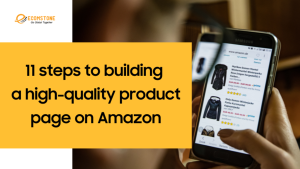On average, 95% of customers read product reviews before buying, mainly to ensure they’re not wasting their money. Buyers on Amazon are no different. In fact, Amazon’s A9 algorithm takes customer feedback and conversion rate into account when deciding a product’s search ranking. So, the consensus among sellers is that negative product reviews are bad. You’re better off not having them.
Well, that’s not entirely true. There are a few good things that negative reviews can benefit sellers regarding Amazon account optimization. Sure, having too many of them can negatively affect your search ranking, but having no negative reviews can also hurt your conversion rate. Plus, negative feedback can also help you, as a seller, long-term. Consider these tips as a guide on how to start an Amazon business, and don’t worry too much about negative product reviews.
By the way, seller reviews and product reviews are different. Seller reviews focus mainly on the customer service side of the business, while product reviews apply to the product itself and everything related to it.
Products with Mixed Reviews Are More Credible
If you think buyers don’t know about some sellers creating fake reviews for themselves, you’d better think again. Most customers are knowledgeable about eCommerce and retail in general. Here are a few reasons why people find mixed reviews more credible.
A 5-Star Rating Could Mean the Seller Only Has a Few Reviews
The Amazon A9 algorithm, like customers, relies on seller authority to rank products. That means the time you’ve been selling is as important as your products. For a new product that hasn’t had a lot of reviews, it’s easy to get a perfect rating. What matters to Amazon is consistency. If you’ve been selling for a long time and your products have consistently gotten good reviews, that means customers trust you as a seller, and Amazon will trust you, as well.
Customer Expectations Are Not the Same
Have you ever heard of the saying, “You can’t please everybody?” That’s doubly true in the retail business. For some reason, it’s so hard to manage customers’ expectations for the products they buy. There could be several reasons why that’s the case:
- Social media has a significant influence on people’s expectations.
- Their expectations are affected by false advertising.
- Buyers feel that the customer should always be right.
- The herd mentality overshadows the desire for individualism.
These reasons make it harder for sellers to please everybody, and customers are starting to know it as well. For that reason, prospective buyers aren’t looking for a seller with a perfect 5-star rating. They’d rather have somebody who has 4.9 stars.
Buyers Expect Honest Reviews
Customers like getting more information about products. The more information they can get, the better they can make informed purchase decisions. Because of that desire, the demand for honest reviews has significantly increased. People want to know the useful features of the products as well as the bad.
Contrary to popular belief, customers knowing about the negative aspects of your product don’t prevent them from buying. The price is still a factor when they decide that. You often see reviews like, “It’s good for the price,” or “It’s worth the price,” and that shows how people factor in the price when it comes to their satisfaction.
Many 5-star reviews without details are just considered fake reviews by buyers. A useful negative product review should have three components:
- The bad aspects of the product.
- How the product helped solve (or didn’t solve) a buyer’s problem.
- How the product compares with others like it.
Negative Reviews Outline Your Product’s Weaknesses
As a seller, it’s always important to improve your products, not just because of Amazon account optimization but also because of the desire to satisfy your customers. You can’t do that without getting information from customers because they’re the ones buying and using your products. If you’re the manufacturer, you can have your development team look at the negative reviews, so they’ll know what other things they can do to develop your product. If you don’t manufacture your product, the negative feedback can be passed on to the manufacturer. Look at the review below.
In the review, the customer complained about a particular weakness of the boots he bought for his daughter. Without this negative review, the manufacturer wouldn’t find out about snow forming at the bottom of the boots’ soles.
The manufacturer explained that they needed to break in the boots before they could perform well in snow. This information can then be added to their Amazon product description, so future customers will know what to expect.
It’s an Opportunity for More Customer Interaction
More customer interaction will benefit your Amazon business significantly. In fact, 84% of consumers want to be treated as a person, not a number. Automated communication is good, but some want more interaction with the seller himself. Talk to your customer and get more information about their negative product review. Let’s talk about the things you can do while talking to your customers. According to a study conducted by Womply, businesses that reply to their customers 25% of the time have an average of 35% more sales.
Confirm the Validity of the Issue
It would be pointless to respond to an issue that isn’t valid. On Amazon, look for “Verified Purchase” at the right of the product variances. If you don’t see it, the negative review might not be a valid one. Create a request to have Amazon remove it. Any sign of profanity might also be grounds for the removal of the negative review.
Acknowledge the Negative Customer Experience
Second, let your customer know that you also feel bad about the negative experience. Empathy is one of the most critical aspects of customer service. Make your customers know that you’re also human, and you understand their situation.
Sincerely Apologize and Offer Solutions
Making excuses is not an option here. It will only make the situation worse. Tell your customer that you regret the negative experience and offer solutions. You can process a refund, replace the product, process a return, offer discounts, or offer freebies in a way that wouldn’t influence the original negative review. Remember, Amazon has policies that penalize people who try to influence customers’ reviews.
Customers Want to Know the Worst-Case Scenario
Buyers are sometimes crafty in choosing the products they purchase. Negative reviews give them a chance to find out the worst-case scenario if they buy from you. A few negative reviews for delayed delivery wouldn’t have a lot of impact on how consumers purchase from you.
Most of them are objective. If they see a negative review that says their purchase was delivered two days late and they gave a one-star rating, they’ll know that kind of rating is pretty harsh for a slightly delayed delivery. It might even make them buy from you because they’ll assume the worst that could happen is a delivery that would be a few days late. Plus, they’ll see that you are a highly credible seller as opposed to someone who doesn’t have any negative reviews.
Mixed Reviews Is Better Than No Reviews
Recent studies show that mixed reviews are a lot better than no reviews. Mixed reviews, at least, give the impression that people have bought from you. No reviews raise a lot of red flags for buyers. They could mean they’re new sellers, sellers suspected of scamming customers, or sellers who are hard to trust.
You Can Update Your Product Listing
In regards to Amazon title optimization and product description, this can be very useful. For example, let’s look at this review.
After seeing this, you can test the validity of the feedback by testing it on your own phone. If the product makes your iPhone overheat inside the car, then maybe the complaint is valid, and you can add something to your product description that says, “This product doesn’t keep your phone from overheating when left inside the car.” Amazon listing experts strongly recommend including these types of information in the product description to manage customers’ expectations.
If you find out that the phone doesn’t overheat with this phone case inside a car, that’s different. You can politely contact the customer and inform him that there could be something wrong with his phone.
Bad Reviews Aren’t the End of the World
If you do get a negative product review from a customer, calm yourself and get to work. It’s not the end of the world. Just remember that having a few of these can be useful to you as a seller. That said, it doesn’t mean your goal is to get as many bad reviews as possible. The point here is not to get discouraged when you get some. Amazon account optimization states it can be good for your business.
If you plan to sell for some time on Amazon, expect a few negative reviews. It’s inevitable. Remember the saying, “Nothing is permanent except death, taxes, and negative reviews.”





